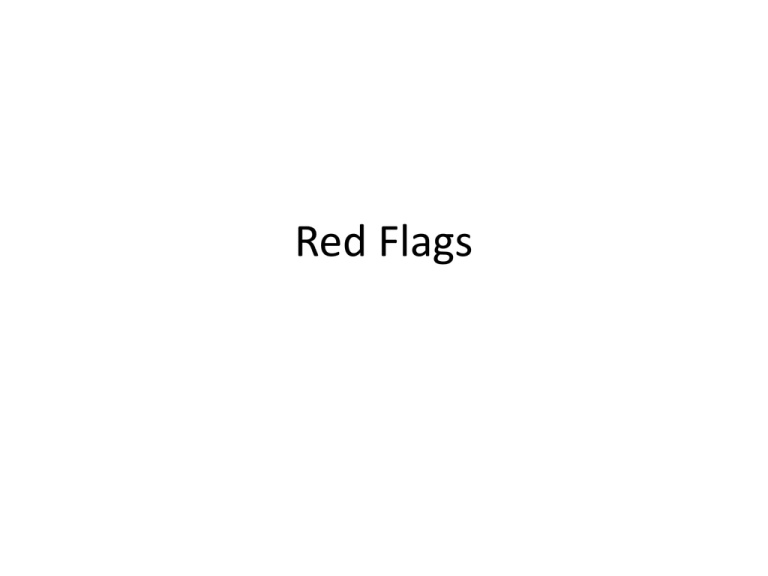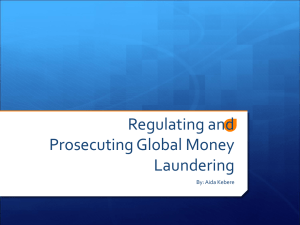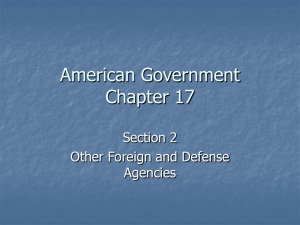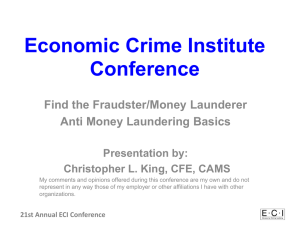Red-Flags-Training
advertisement

Red Flags Introduction • Purpose: – To show visually what bankers may see in transactional activity that may uncover certain financial crimes. • The red flags are reviewed from the FFIEC BSA / AML Manual as well as FATF reports on criminal activity Introduction – Red Flags Noticed – Questions to ask from line staff – Due Diligence to perform (if not already documented) – Other items that can be researched / investigated Red Flags • Red Flag Examples Part 1 Money Laundering • The following examples are meant for bankers to visually note transactional activity they may notice in review of their everyday reports. These are only of few examples of many and will hopefully help to develop a reporting structure to make a more efficient and well documented AML Program. These examples are simple and brief, good launderers may have very complex and intricate laundering schemes • It’s important for bankers to stay up to date on all current information provided by law enforcement, FinCEN and your regulator. Red Flag Review and Examples: Stages of Money Laundering Money Laundering • Money Laundering – is the criminal practice of processing ill-gotten gains, or “dirty” money, through a series of transactions; in this way the funds are “cleaned” so that they appear to be proceeds from legal activities. Money laundering generally does not involve currency at every stage of the laundering process. Although money laundering is a diverse and often complex process, it basically involves three independent steps that can occur simultaneously: Placement • Placement: The first and most vulnerable stage of laundering money is placement. The goal is to introduce the unlawful proceeds into the financial system without attracting the attention of financial institutions or law enforcement. Placement techniques include structuring currency deposits in amounts to evade reporting requirements or commingling currency deposits of legal and illegal enterprises. What to look for Red Flags • Exact dollar amounts (not all the time) • Business customer that does not usually have large amounts of cash ins. • Cash intensive businesses that split their deposits to avoid reporting requirements • None of the cash ins are over $10,000.00 • Cash ins in some cases are performed on the same business day, however, different branches are used. • Not all placement transactions are cash look at online transactions for possible placement of illicit funds. What to look for Backroom Reports Review • Transactions with large frequent cash ins • Online payment transactions that have little information provided and are unusual for the type of business and / or account holder • Any linkage between customers that may be noted in CIP / CDD information (i.e. occupation type of business, expected activity etc) • Look destination of funds where and who the funds go to and how they got there. Front Line staff: Key Points • Exact amount cash in • Any comments the customer makes concerning the transactions or their business • Any mention of the reporting thresholds when deposits made. Documentation recommended • Any notes from the front line on comments the customer may have made • The source and destination of funds • All web searches for information on the customer and customer’s business • Obtain and document beneficial ownership of any business the customer may open or be associated with Example 1 • Smart 1 is a real estate business in reviewing cash reports it is noticed numerous high dollar cash ins, the cash ins are exact amounts and are all under the reporting threshold. The cash ins are made at different branches on the same business day in some cases. Example 1 In the report below see the exact dollar amounts of cash in structured over multiple days, as well as some deposits made on the same day different branches. Note the business type and research to see why a Real Estate business may have large cash ins (document any findings) Different branches used on the same day Exact Dollar Amounts Cash in Summary Example 2 • Customer makes large cash deposit containing many larger denomination bills, such as the 500 euro note or US$100 bills • Customer frequently deposits large sums of cash wrapped in currency straps stamped by other banks or currency wrapped in rubber bands that is disorganized and does not balance when counted. • Denise Menace is a Construction worker; Mr. Menace makes frequent cash deposits into his personal account. If known look at the occupation of the customer does the cash in “fit” the type of business or occupation? Example 2 Note from the transactional activity the exact amount of cash in under the reporting threshold ($10,000.00) on consecutive days. Document any information from the teller as to how the cash is deposited (i.e. denominations, strapped or unstrapped etc) Notice large exact amount of cash ins into personal account Summary Example 3 Smurfing • Joe Smith is noticed purchasing several cashier’s checks for cash in amounts that would not be recorded. Notice exact amount cash in for the checks or possible a deposit of cash then purchase of a check Example 3 Smurfing Cash in for cashier’s check purchases under the $3,000.00 amount (some people see the $3,000.00 in for cashier’s checks as a reporting threshold) Look at the payees on the checks note if they are the same or different, to a business or person and what the relationship may be. Review the payees of the checks purchased, are there any known links between the purchaser and Payee Summary Example 4 Prepaid Cards • Joe Smith is noticed depositing cash his personal account, then purchases prepaid cards for the amount of cash deposited. Example 4 Prepaid Cards From the report sample you can see exact amount of funds in from cash in or cash purchases prepaid cards. Be sure to adjust your thresholds and look periodically at all transactions in and not to see if there are holes in the report that need to be fixed and thresholds need to be updated. Depending on your bank’s risk, you may need to assess the thresholds at least quarterly Look at the velocity of funds in and funds out and source and destination of funds, document any findings Review your prepaid card procedures: Do you have limits on amount or number of cards sold? Can the prepaid cards be used at ATMs to withdraw cash? Can the prepaid cards be reloaded? Look at the velocity of funds in and out how fast is the turnaround Summary Layering Layering • Layering. The second stage of the money laundering process is layering, which involves moving funds around the financial system, often in a complex series of transactions to create confusion and complicate the paper trail. • Examples of layering include exchanging monetary instruments for larger or smaller amounts, or wiring or transferring funds to and through numerous accounts in one or more financial institutions. What to look for Red Flags • Transactions with exact dollar amounts (not all the time) • Velocity of funds into and out of accounts • Internal transfers between accounts • High Volume of Wires and ACH transactions in and out – Especially to high risk locations What to look for Backroom Reports Review • Transactions with exact dollar amounts (not all the time) • Look destination of funds where and who the funds go to and how they got there. – Are the funds going to places associated with your customer • Online payment transactions that have little information provided and are unusual for the type of business and / or account holder • Any linkage between customers that may be noted in CIP / CDD information (i.e. occupation type of business, expected activity etc) • Funds Transferred to high risk locations (i.e. off shore tax haven accounts) Front Line staff: Key Points • Transactions with exact dollar amounts • Any comments the customer makes concerning the transactions or their business • Any mention of the reporting thresholds when deposits made (not only for cash but for other transactions as well) Documentation needed • Notes from the front line on comments the customer may have made • Source and destination of funds • Who the funds go to or come from and any linkages found in the review • All web searches for information on the customer and customer’s business • Obtain and document beneficial ownership of any business the customer may open or be associated with Layering 1 • Customer withdraws cash, in $100 bills, in amounts under the reporting threshold, from accounts where funds derived from fraud schemes were deposited Notice the large ACH in from online payment processors Layering 1 From the report sample below you can see exact amount of funds in from online payment systems also look for other money transfer vendors. Look at the velocity of funds in and funds out and source and destination of funds, document any findings Note the exact amount cash outs following one or two large ACH transactions in Summary Layering 2 • Customer has numerous ACH / Fund Transfers in and out that are exact dollar. Notice the large ACH in from online payment processors Think about the type of business, do the transactions fit the normal activity Layering 2 From the report sample you can see exact amount of funds in from Pay-Me also look for other money transfer vendors. Look at the velocity of funds in and funds out and source and destination of funds, document any findings Note the exact amount out following one or two large ACH transactions in Summary Integration Integration • The ultimate goal of the money laundering process is integration. Once the funds are in the financial system and insulated through the layering stage, the integration stage is used to create the appearance of legality through additional transactions. These transactions further shield the criminal from a recorded connection to the funds by providing a plausible explanation for the source of the funds. • Examples include the purchase and resale of real estate, investment securities, foreign trusts, or other assets. What to look for Red Flags • Transactions with exact dollar amounts (not all the time) • Velocity of funds into and out of accounts • High Volume of Wires and ACH transactions in and out – Especially to high risk locations • Look for large dollar purchases that are unexplainable • Review large payments off to loans or credit cards • Numerous exact dollar transactions with possible investment firms What to look for Backroom Reports Review • Transactions with exact dollar amounts (not all the time) • Look destination of funds where and who the funds go to and how they got there. – Are the funds going to places associated with your customer • Online payment transactions that have little information provided and are unusual for the type of business and / or account holder • Any linkage between customers that may be noted in CIP / CDD information (i.e. occupation type of business, expected activity etc) • Funds Transferred to high risk locations (i.e. off shore tax haven accounts) Front Line staff: Key Points • Transactions with exact dollar amounts • Any comments the customer makes concerning the transactions or their business • Any mention of the reporting thresholds when performing transactions (not just cash). Documentation needed • Any notes from the front line on comments the customer may have made • The source and destination of funds • All web searches for information on the customer and customer’s business • Use Pivot tables and other analytical programs to summarize and analyze the data • Obtain and document beneficial ownership of any business the customer may open or be associated with Integration Example 1 • Purchase and resale of real estate • Customer makes frequent loan payments for large exact amounts, you may notice a short time period in the loan give and the payoff of the loan Integration 1 From the report sample you can see exact amount of funds going to make loan payments either directly to the loan or from a checking account the funds went into. Be sure to adjust your thresholds and look periodically at all transactions in and not to see if there are holes in the report that need to be fixed and thresholds need to be updated. Depending on your bank’s risk, you may need to assess the thresholds at least quarterly Look at the velocity of funds in and funds out and source and destination of funds, document any findings Summary Integration 2 • Investment securities, foreign trusts, or other assets • Customer has large deposits either from wire, check or cash then transfers the funds to investment accounts in his their Integration 2 From the report sample you can see exact amount of funds in and out and the type of transaction being utilized. Review the destination of the funds and the names of the investment companies; it may be possible to do a 314 (b) request to find more information on where the funds went and if they stayed in the account. Be sure to adjust your thresholds and look periodically at all transactions in and not to see if there are holes in the report that need to be fixed and thresholds need to be updated. Depending on your bank’s risk, you may need to assess the thresholds at least quarterly. Look at the velocity of funds in and funds out and source and destination of funds, document any findings Summary Putting it all together • Review Reports and Monitoring – When you see something unusual document what you have done to explain the transactions, if you perform a search and find nothing document the search performed and state you had no results. – For customers that seem to have complex and unusual activity other tools may be needed to help to paint a picture of what is occurring and to help explain the activity. Putting it all together • Obtain and document beneficial ownership of any business the customer may open or be associated with





